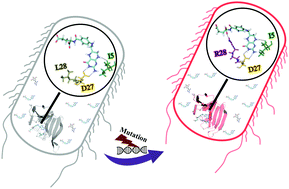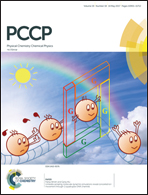Increased substrate affinity in the Escherichia coli L28R dihydrofolate reductase mutant causes trimethoprim resistance†
Abstract
Dihydrofolate reductase (DHFR) is a ubiquitous enzyme with an essential role in cell metabolism. DHFR catalyzes the reduction of dihydrofolate to tetrahydrofolate, which is a precursor for purine and thymidylate synthesis. Several DHFR targeting antifolate drugs including trimethoprim, a competitive antibacterial inhibitor, have therefore been developed and are clinically used. Evolution of resistance against antifolates is a common public health problem rendering these drugs ineffective. To combat the resistance problem, it is important to understand resistance-conferring changes in the DHFR structure and accordingly develop alternative strategies. Here, we structurally and dynamically characterize Escherichia coli DHFR in its wild type (WT) and trimethoprim resistant L28R mutant forms in the presence of the substrate and its inhibitor trimethoprim. We use molecular dynamics simulations to determine the conformational space, loop dynamics and hydrogen bond distributions at the active site of DHFR for the WT and the L28R mutant. We also report their experimental kcat, Km, and Ki values, accompanied by isothermal titration calorimetry measurements of DHFR that distinguish enthalpic and entropic contributions to trimethoprim binding. Although mutations that confer resistance to competitive inhibitors typically make enzymes more promiscuous and decrease affinity to both the substrate and the inhibitor, strikingly, we find that the L28R mutant has a unique resistance mechanism. While the binding affinity differences between the WT and the mutant for the inhibitor and the substrate are small, the newly formed extra hydrogen bonds with the aminobenzoyl glutamate tail of DHF in the L28R mutant leads to increased barriers for the dissociation of the substrate and the product. Therefore, the L28R mutant indirectly gains resistance by enjoying prolonged binding times in the enzyme–substrate complex. While this also leads to slower product release and decreases the catalytic rate of the L28R mutant, the overall effect is the maintenance of a sufficient product formation rate. Finally, the experimental and computational analyses together reveal the changes that occur in the energetic landscape of DHFR upon the resistance-conferring L28R mutation. We show that the negative entropy associated with the binding of trimethoprim in WT DHFR is due to water organization at the binding interface. Our study lays the framework to study structural changes in other trimethoprim resistant DHFR mutants.



 Please wait while we load your content...
Please wait while we load your content...